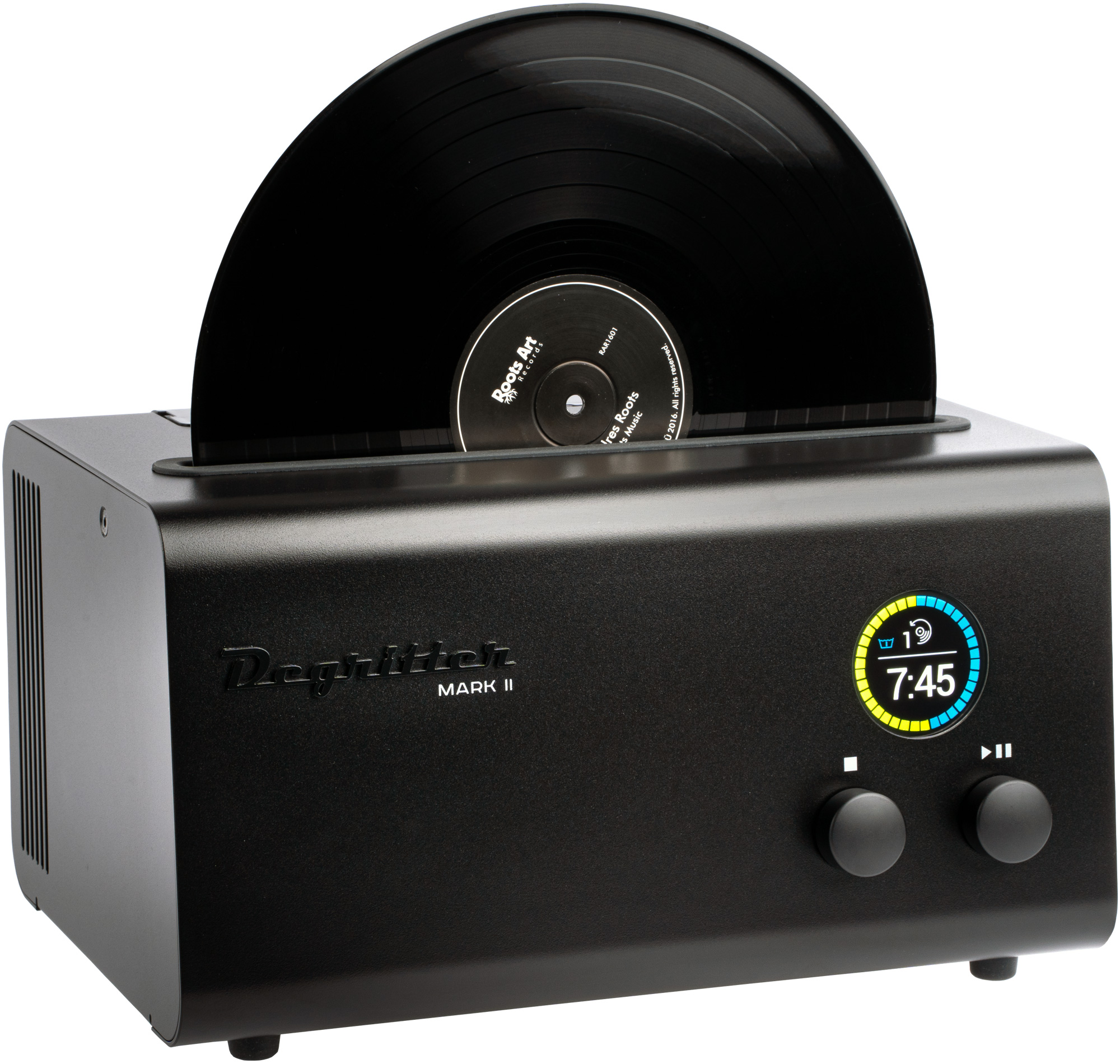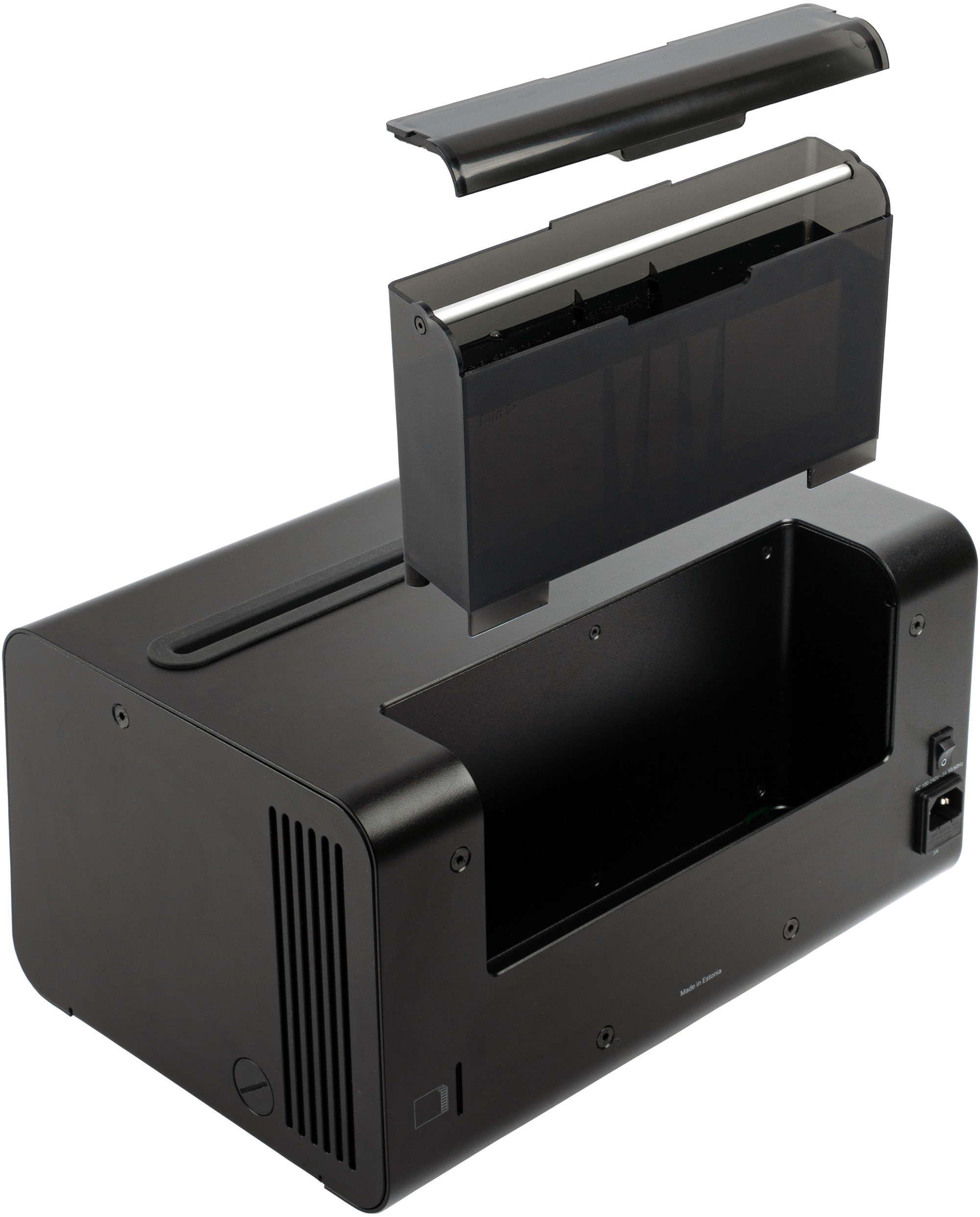The fact that the technology is fairly new, and that there were some indications to me that there might well be different results with different machines, and that my local hi-fi dealer started carrying the Degritter brand of ultrasonic cleaners, with which he was very pleased, caused me to think, why not try something new?
Hence, my purchase of a Degritter (and liking it), and the development of this review.
So, here is how the Degritter works (and the machine I am using is a newer model Degritter MK II:
Nuts and Bolts (Degritter MK II)
The Degritter MK II is built like a proverbial tank, but with a pleasant industrial vibe where form follows function. The following description of some of the more salient features relies heavily on the information provided in the Degritter 2 “User Guide”.
Cavitation
Ultrasonic cleaning has a unique ability to remove dirt that is not easily accessible by using other traditional means. The smallest features in a vinyl record groove are a few micrometers in size. Due to their minute size, it is difficult for the bristles of a traditional record cleaning brush to clean the entirety of the record groove. Ultrasonic cleaning works by agitating the cleaning liquid with high pressure acoustic waves. This creates a large number of microscopic vacuum bubbles in the liquid, a phenomenon called cavitation. With every pressure wave, countless small vacuum bubbles are created and collapsed releasing heat and water jets toward the record. This action will safely loosen and remove dirt and contaminants from the record.
4 Transducer Layout
The wash tank employs two ultrasonic transducers on either side emitting 120 kHz ultrasonic vibrations to evenly distribute the energy across the record surface.
Pulse Mode Cleaning
During pulsing, the ultrasonic transducers rapidly switch on and off on high power. This enhances cavitation in the water but keeps power usage low.
Frequency Sweep
The driving frequency of the ultrasonic generator sweeps between 120-125 kHz to even cavitation energy distribution.
300 Watts
The average power output of the washing programs is 300 watts, which makes the Degritter the most powerful ultrasonic record cleaning machine on the market per liter of water. The higher 120 kHz cleaning frequency is designed to keep records safe.
Active filtering
Cleaning water is pumped through a replaceable filter during washing.
Record-safe Temperature Control
The Degritter monitors the temperature of the water during cleaning to prevent damage to the vinyl.
Most importantly, the machine is fully automatic.
Using the Degritter MK II
I have used the Degritter for several months now, and have found that it works simply and easily, as described. I am glad to get away from the rollers that were part of the process with the Audio Desk. They were a pain to clean. Plus, with the Audio Desks that I had, often there were still droplets of water on the records after I pulled them out of the Audio Desk, which I then had to clean off with a lint-free towel. If there were a lot of drips, I would sometimes conclude to rinse the records separately with a vacuum-type cleaner, which was another hassle. After you clean a lot of records, the cleaning water begins to get somewhat contaminated, which of course, complicates matters. The extra attention often made some difference.
The Degritter water tank is so much smaller than that of the Audio Desk that it can be easily removed for cleaning. So, cleaning of the machine is notably easier: no brushes to fool with and much less water to drain. Since the Degritter uses far less water, I feel no hesitation about changing the water out after I have cleaned about 20 records. Cleaner water, happier records. I would go about 50 records before draining and cleaning the Audio Desk with its much larger tank. Also note that the tank of the Audio Desk is not removable so while it can be drained, it cannot really be cleaned.
Cleaning quality differences between the Degritter, the Audio Desk, and the KL Audio
First, before delving into differences between the machines, let me deal with the more basic issue: How much difference does cleaning make? Is it really worth the hassle? The simple answer is absolutely. Indeed, for readers that have come this far, I assume that there is a belief that cleaning records, in general, improves matters. It’s simple: There are mold release compounds on records when new. As we play them, records collect dust and grit, much abetted by static electricity. Second-hand records that we buy have typically been around for decades by the time we acquire them. The buildup of contaminants is unavoidable. It affects how our styluses track the grooves, which is audibly noticeable even more so depending upon the quality of the playback system. For these reasons, record cleaning is an important part of enjoying vinyl reproduction, whatever method you use.
When ultrasonic machines first came into use for record cleaning purposes, I was somewhat skeptical that they would be so clearly superior to my usual methods. One afternoon, my friend with the KL Audio machine challenged me: He would clean one of my already-cleaned LPs with his machine and we could experience an A-B comparison. We did, and I was taken aback by the result. The grooves were quieter, there was less noise, and, most gratifying, the soundstage, the detail, and the air around the instruments were notably improved. That experience alone convinced me that ultrasonic cleaning was worth experimenting with, at a minimum.
However, that comparison alone, was not entirely dispositive. In my experience, comparing cleaning methods for quality evaluation is really quite difficult. That is because comparing a record cleaned with one method to the same record after a second cleaning with a different method almost always appears to show an improvement over the first cleaning. That is my experience. Whatever the methods involved, I have noticed time and again that a second cleaning of a record using a different method seems to almost always benefit the record to some degree. I have concluded from this that the different methods, ultrasonic versus enzymatic versus alcohol (highly diluted), attack different types of contaminants, particularly with used records.
So, while I would like to be able to tell the reader exactly what quality differences there are between the three ultrasonic machines I’ve been able to get to know, I cannot evaluate that difference scientifically. Even though I have not actually “driven” the KL Audio machine, I am very familiar with the results it obtains, given the several hundred LP’s I have that were cleaned with one by my friend, as described above. However, what I can do is describe my observations after having heard hundreds of records cleaned with these three methods. Similarly, I can reflect on my experiences with hundreds more records cleaned with enzymes, alcohol, etc. So, here goes:
I have been most consistently impressed with the results obtained by the KL Audio machine. The surfaces are the most consistently quiet. Detail, air, etc., are consistently superb. I find this a bit peculiar because there are no cleaning additives used in the KL Audio process. But that’s what I hear. I need to add that I have nevertheless gone on to perform enzyme cleans on some records that were still noisy after the KL Audio cleaning. Sometimes, something as simple as a rinse with lab grade water would take the cleaning to another level.
I’ve found the Degritter to be a strong second. I also really like the simplicity of its “clean and done” type operation. Candidly, I have never tried the Degritter cleaning additive, because I’ve become very enamored of the AI additive. I’ve also never tried the Degritter without any additive. I am so satisfied with the end result that I am getting, that I don’t feel the need. And the end result is also close enough (perhaps equal) to the KL Audio that I haven’t felt a need to pony up for the extra cost of the KL Audio machine.
I am not prepared to say that the Audio Desk is not as good as the Degritter in any definitive way. However, in comparing the simplicity of operation, the water droplet issue, and the more complicated maintenance of the Audio Desk, I have concluded to set it aside for now in favor of the Degritter. It is difficult to resist the simple operation and excellent results which the Degritter provides.
But I want to be clear: I still include in my arsenal my vacuum-type cleaner and my AI fluids, described above. About 20% of the time, particularly with older or more heavily played records, these fluids, or even just a rinse with the AI water, can be additive enough to be worth doing. I really don’t like having to go to further trouble – cleaning records is not the most fun thing I do in a day (although it does have its own Zen-like aspect), but a record I really like can be worth the extra effort.
So, I end by recommending the following cleaning regimen: Start with an ultrasonic cleaning. You can adjust the timing of the cleaning; I have found with the Degritter that the 3+ minute cycle, plus drying, is usually sufficient. If your ears are curious whether better results can be obtained, use a different method next: the AI fluids and a vacuum type of machine are an excellent alternative. Experiment and listen.
My recommendation overall for an ultrasonic machine is now the Degritter for the reasons described above. Since the ultrasonic machines are complicated, it makes sense to me to consider in the equation what is available locally that can be serviced, at least to a degree. In all fairness, I should also state that I have not owned the Degritter MK II long enough to unequivocally state that it is more reliable than other machines; however, my dealer friend (Timbre Audio – Houston) has cleaned thousands of records on his Degritter with no maintenance issues. Likewise, it is worth noting that the machine is manufactured in Estonia.
- ← Previous page
- (Page 2 of 2)


This article only scratches the surface (pun intended). Audiodesk was the pioneer, but Degritter II leaves it biting the dust (pun intended). I know because I own both. Fred and Earl have no idea how good DII really is. DII includes a 2-tank programme: after 5 min wash in tank I, swap for tank II for a further 2 min rinse. DII prompts all the steps for the tank swap. I personally dry the record on a Project vacuum machine to save time and make sure no water is left in the grooves. I personally pre-wet my records with diluted Tergikleen, wash in distilled water tank I without additives, rinse in distilled water tank II without additives, dry: total 10 minutes, about 6 records/hr. One day, I should check out adding the Degritter improved formula additive in tank I, skipping the Tergikleen step. I wash all NEW records this way, obtaining MASSIVE sound improvement that belies belief. I consider DII an indispensable vinylista piece of kit. I have no experience with other solutions.
Thanks for your comments. I wanted to mention that in the past, I used two Audiodesk machines, one for wash and one for rinse. Since switching to the DII and the Audio Intelligent fluid, I normally notice little improvement from a rinse although sometimes it helps. Note that I purchased an additional tank for rinsing. I play records on my Rockport Sirius/Lyra Atlas lambda SL though an Audio Note M9 RIAA SIGNATURE.